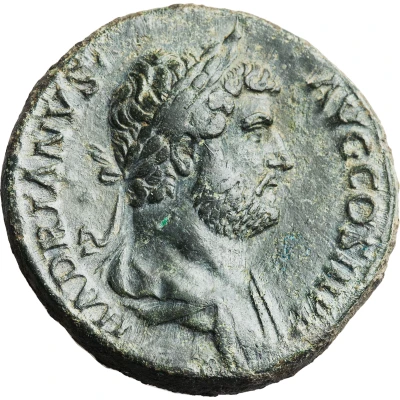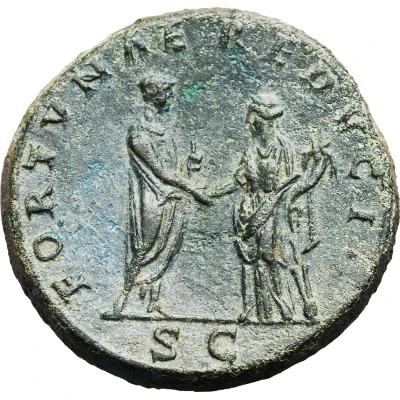Sestertius - Hadrian FORTVNAE REDVCI S C; Fortuna
| Orichalcum | 25 g | 32.5 mm |
| Issuer | Rome › Roman Empire (27 BC - 395 AD) |
|---|---|
| Emperor | Hadrian (Publius Aelius Hadrianus) (117-138) |
| Type | Standard circulation coin |
| Years | 133-135 |
| Value | 1 Sestertius = ¼ Denarius |
| Currency | Denarius, Reform of Augustus (27 BC – AD 215) |
| Composition | Orichalcum |
| Weight | 25 g |
| Diameter | 32.5 mm |
| Shape | Round (irregular) |
| Technique | Hammered |
| Demonetized | Yes |
| Updated | 2024-10-06 |
| Numista | N#256571 |
|---|---|
| Rarity index | 97% |
Reverse
Hadrian standing right, holding scroll and greeting Fortuna, standing left, holding cornucopia and rudder ususally on globe.
Script: Latin
Lettering:
FORTVNAE REDVCI
S C
Translation:
Fortunae Reduci. Senatus Consultum.
To returning fortune. Decree of the senate.
Comment
Source: Online Coins of the Roman Empire (OCRE)Interesting fact
The Sestertius coin features an image of Fortuna, the Roman goddess of luck and prosperity, on one side, and Emperor Hadrian on the other. The coin was minted during Hadrian's reign (117-138 AD) and was used as a standard circulation coin throughout the Roman Empire. The use of Orichalcum, a copper-zinc alloy, was a common practice during this time period, as it was a durable and cost-effective material for coin production. It's worth noting that the coin's design and materials were carefully chosen to convey the power and authority of the Roman Empire, and the image of Fortuna was likely intended to symbolize the Empire's prosperity and good fortune.

